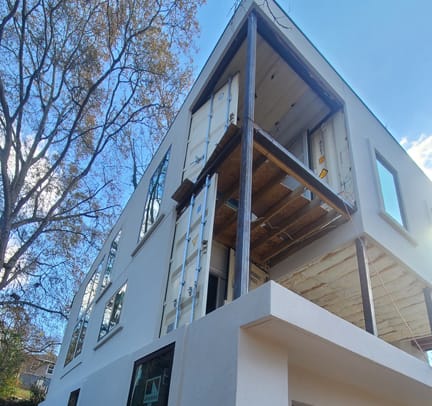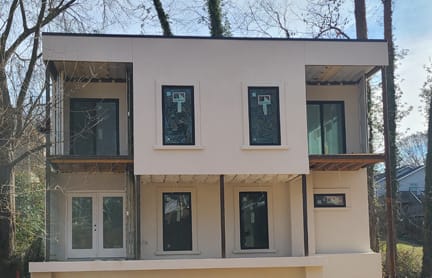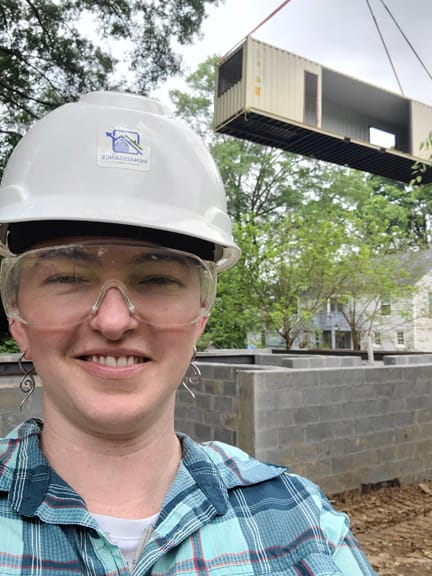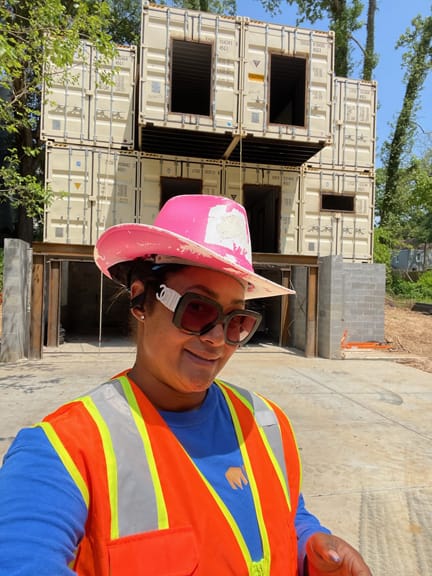




By Robert M. Sarwark
Joy Keltner, of Grant Park, and business partner Marie Johnson have combined forces to create a new, exciting paradigm for residential homes in our area.
Ten years ago, Keltner and Johnson were both project managers at a Fortune 500 company. Today, the pair is on the brink of completing a 3,000-square-foot home in the Edgewood neighborhood, between East Atlanta Village and the Edgewood Retail District shopping center. But this particular house was made in a manner that you may not have expected given the nearby architecture: from eight shipping containers.
What does it take to build with shipping containers? “There’s a myth that containers are a super cheap way to build,” Keltner explained. “But that’s not really true. Nearly as much lumber is required for a container house as for a ‘stick’ build, not to mention the costs of land and utility connections!” What’s more, Atlanta has specific requirements for shipping-container builds. “The city wants to know the whole shipping history of the container to ensure any hazards from cargo are eliminated,” Keltner added. Since this information can sometimes be hard to find, Johnson and Keltner have opted to purchase new containers rather than take any risks on used ones.
The design and construction phases of their current project posed unique challenges to the builders; they had to find additional team members who had experience with metal construction. “A structural engineer was hired to design reinforcements that would allow several containers to be opened into a single larger living space,” Johnson, who serves as the project’s general contractor, explained. “We also had to coordinate with plumbers, electricians, and welders to make sure we could route all the utilities through metal walls where needed.” In order to make sure all the containers were waterproof, a stucco siding system was selected. This system also included insulation to help keep the containers cool.
With much of the containers’ exteriors covered, Keltner wanted to make sure that their unique architectural style was visible wherever possible: “Three of the original containers have their doors exposed on the exterior of the home,” she said. “Ceilings were another good place to leave the original metal exposed, though wood channels had to be built to allow for running electrical lines and plumbing.”
So what is the main advantage of building with shipping containers as opposed to more traditional materials? “Strength!” Keltner emphasized. Typical wood-frame houses are held together with screws and nails, with a few metal “hangers” to help attach the roof to the walls. But a shipping-container house is welded. The foundation walls are filled with concrete and metal plates are embedded in the block walls. The containers are themselves welded to these plates, to each other, and also to structural steel supports in the garage. “If there’s a tornado, this house will be where everyone on the block wants to take shelter,” Keltner hastened to add.
Joy Kelter and Marie Johnson’s first container home should be wrapping up this spring, but the pair are already thinking of the next project. Their current project is a collaboration between Johnson’s firm, Minoch Construction Group, Inc., and Keltner’s, Renaissance Structures, LLC, and they plan to continue with this women-led partnership. In the future, they hope to attract local buyers wanting to design their own unique container concepts. There aren’t many builders in Atlanta doing this kind of work, both asserted, but they hope to be seen as the market experts.
Find more information and follow the construction project on social media at: @minochconstruction/@renaissance_structures (Instagram) or @bossladybuilder (TikTok).




